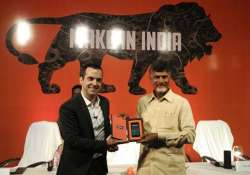Xiaomi Redmi 2 Prime: Company's first 'Made in India' phone launched at 6,999
Visakhapatnam: Chinese low-cost smartphone manufacturer Xiaomi on Monday unveiled its first made in India smartphone here.Launching the Redmi 2 Prime, Andhra Pradesh Chief Minister N. Chandrababu Naidu said: "We have great faith in young leaders

Visakhapatnam: Chinese low-cost smartphone manufacturer Xiaomi on Monday unveiled its first made in India smartphone here.
Launching the Redmi 2 Prime, Andhra Pradesh Chief Minister N. Chandrababu Naidu said: "We have great faith in young leaders and young companies like Xiaomi. These new generation companies and entrepreneurs will be key to the success of Andhra Pradesh and India.
"We believe this partnership will provide new opportunities to youth of the state and develop an electronics manufacturing ecosystem of global standards in Andhra Pradesh."
Union Industrial Policy and Promotion Secretary Amitabh Kant, who was also present, said: "Xiaomi is a unique example of 'Invested by China, Made in India'. Xiaomi is known for its quality technology and craftsmanship, and has an immense following amongst young India. I am sure they will make India their home and open many more production facilities."
Priced at Rs.6,999, Redmi 2 Prime has 16 GB internal memory.
Xiaomi said that it has already begun manufacturing smartphones in the state's Sri City, a planned business city on the Andhra-Tamil Nadu border, 55 km north of Chennai, in partnership with contract electronics assembly manufacturer Foxconn.
"Manufacturing smartphones locally is a significant step towards incorporating Xiaomi into the fabric of India in the years to come. Thanks to Prime Minister Narendra Modi's visionary plan to transform India into an attractive destination for manufacturing, we have a great opportunity to make our products in India, bringing us even closer to Indian consumers and contributing to India's evolution in the technology sector," said Xiaomi Global vice president Hugo Barra.
The Sri City facility is Xiaomi's second manufacturing base in the world after Brazil.
On choosing Sri City, Barra said Xiaomi had discussions with Andhra chief minister when he had visited Beijing, while at the same time, Foxconn was also in talks with him.
"After taking into consideration several factors, manufacturing in Andhra Pradesh was an obvious choice for us. This has been possible due to the support of Chief Minister Chandrababu Naidu and his forward-thinking policies, as well as Ashok K. Kantha, ambassador of India to China, who played a key role in helping us to forge links with Andhra Pradesh," he said.
Stressing Andhra's advantages, Xiaomi India CEO Manu Jain said: "We started looking at options for local manufacturing as soon as Xiaomi entered India in July last year. Andhra Pradesh is more conducive to new smartphone companies like us."
"The choice of location is strategic as Andhra Pradesh is known to have highly skilled technical manpower, an enterprising population and a dynamic emerging leadership - a combination of factors that make the state appealing to high-growth technological companies such as Xiaomi."
Barra said the assembly line in Sri City is exclusive for Xiaomi products and will cater to all being consumed in India. "Although we have the option to expand the assembly lines, we are not looking at exporting from India right now," he added.
Jain said that the plant will ensure overall delivery time reduction by nearly two weeks... most of the phones that we sell in India will be made in India".
Xiaomi will however assemble phones here and not make them entirely although Barra has promised to help bring the component ecosystem to the country.
"Local manufacturing shows Xiaomi's commitment to being in India for the long haul, and we are also able to contribute to generating more jobs in India," he added.
Asked about the sales model of the new device, Xiaomi, which has sold nearly 3 million smartphones in the country, said that it was not going for any flash sales for this particular product. "We only go for flash sales when we see an inequilibrium in the demand-supply scenario," Jain added.